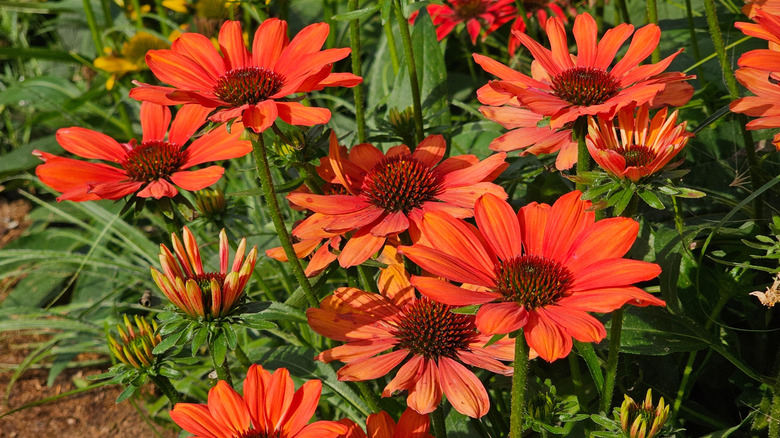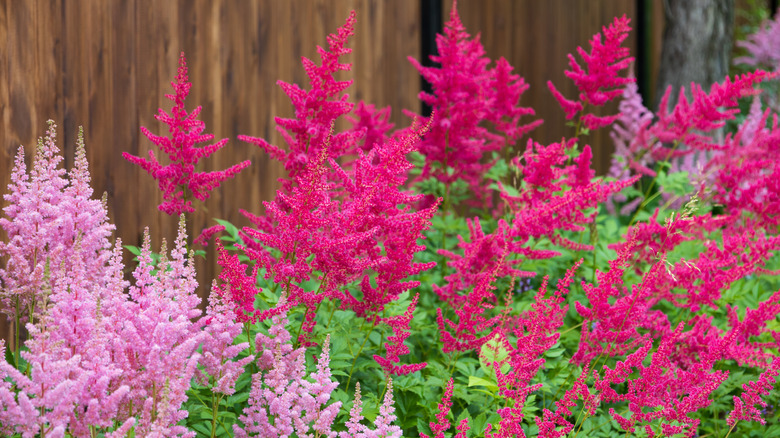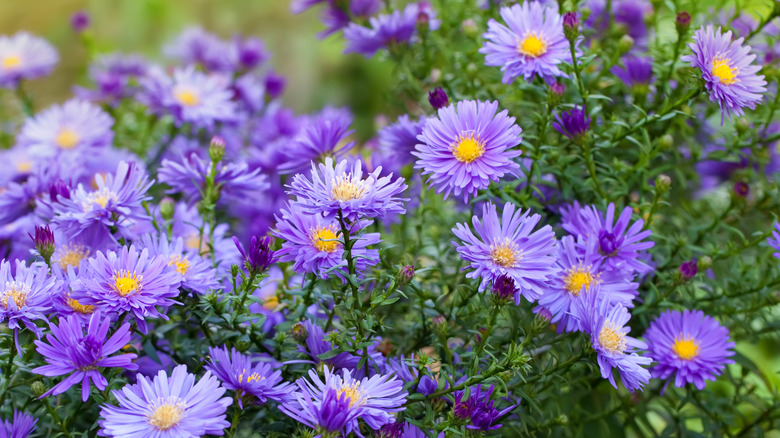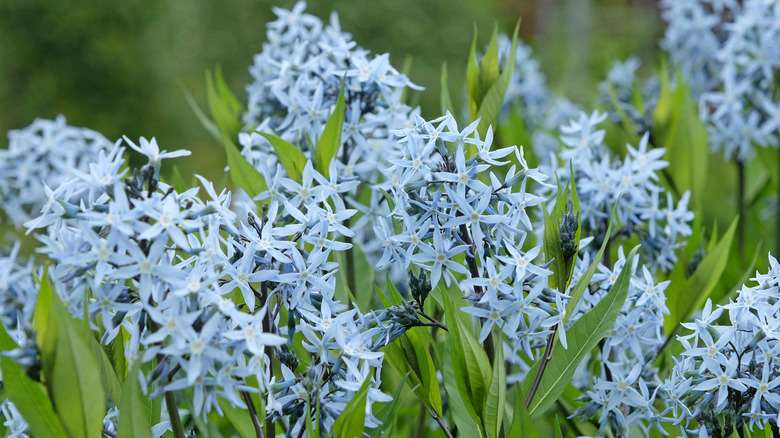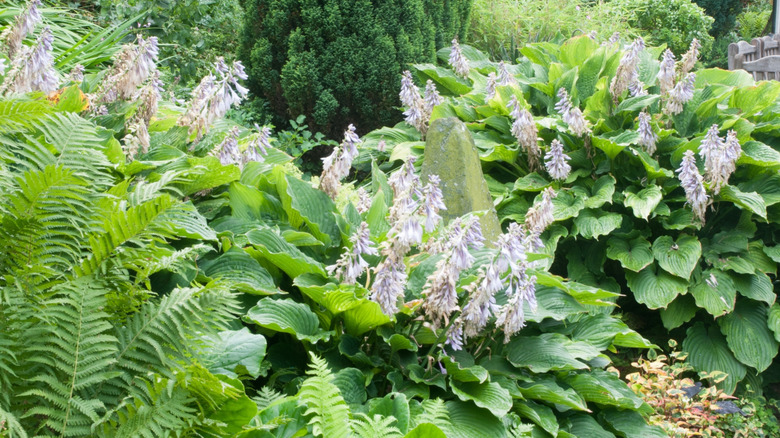Create A Low-Maintenance Flower Garden With 15 Perennials You'll Love
As a professional gardener, perennials are my bread and butter. Whether I'm designing a new garden for a client or maintaining an established one, perennials are the backbone of the border, offering many possibilities suitable for a range of soil and light conditions, as well as unlimited choices of color, shape, and texture. Some of my clients like to do their own gardening, and often ask me to recommend low-maintenance flowering perennials. These are the ones I'm most likely to recommend for their versatility and easy care.
Most perennial flowers require a bare minimum of care, including regular watering, some deadheading at least once per season, and dividing every two or three years. Some perennials are fussier than others, but their beauty makes them seem worth it: For example, bearded irises have somewhat tricky planting needs and need deadheading or trimming throughout the season. Some perennials are "messier" than others, and others reseed themselves or spread quickly, which also makes more work for gardeners.
The criteria I considered for these easy-care flowers listed here are: Cold hardy within USDA zones 5 through 9, long-lived plants that increase in size gradually, long season of blooms requiring minimal deadheading, no special watering or fertilizing needs, and easily divided and replanted in spring or fall. I also chose the flowering perennials, like sedums, day lilies, tall phlox, and astilbe, that I enjoy seeing in the garden, and that my clients enjoy the most, year after year.
Sedum
These hardy, beautiful succulents are super easy to care for, and can be divided or replanted at any time without missing a beat. Sedums (also called stonecrop) offer four seasons of low-maintenance beauty, and their constant transformation from spring buds to autumn flowers offers plenty of visual texture. They provide great winter interest in the garden too. Some of my favorites are 'Matrona' (red stems, pink flowers), 'Neon' (hot pink flowers), and 'Thunderhead' (round magenta flowerheads). Sedums thrive in partial shade to full sun and are very drought-tolerant.
Day lilies
Not to be confused with the somewhat invasive wild orange 'ditch lily' (Hemerocallis fulva), species day lilies (Hemerocallis spp.) come in a huge variety of cultivars, most with bi-color contrasting hues, making them very eye-catching. Because the blooms only last a day, they do require a bit of deadheading to keep them neat. But otherwise, they only need full sun, well-drained soil, and regular watering to thrive. The thick root clumps help deter weeds, yet are fairly easy to divide, which should be done about every three years.
Coneflowers
Coneflowers (Echinacea) are sturdy daisy-like flowers with prominent cone centers that come in many warm, vivid colors. Some newer hybrids have pom-pom centers without seeds, but the seed cones attract songbirds in autumn. Coneflowers also attract pollinators and birds, and bloom for weeks from mid-summer through autumn. You can deadhead them a bit as blooms fade, or let them go to seed to feed wildlife, then clean them up in spring as new growth appears. They bloom best in full sun, but are not fussy about soil and are drought-tolerant.
Astilbe
These shade-loving perennials have fluffy plumes of pink, red, white, or purple flowers that add colorful beauty to shady corners of the garden. Beautiful and robust astilbes require minimal care. They do best in well-drained, rich soil and need regular watering. Once the blooms start to fade, leave the flowers intact for winter interest. The clumps increase nicely in size over time and should be divided every three or four years. Some of my favorite varieties are 'Maggie Daley' (lavender-pink), 'Delft Lace' (soft pink with red stems), and 'Red Sentinel' (scarlet red with burgundy stems).
Asters
Asters are wonderful late-season flowers that add bold color to the garden from late summer through autumn, just as most perennials are starting to wind down. Asters are easy to grow, and other than a bit of deadheading to keep blooms coming in the fall, require little maintenance. They bloom best in full sun, but I get plenty of flowers from 'Woods Blue' and 'Woods Pink' in my partial shade garden. There are both tall and compact cultivars in a dazzling variety of cool-toned colors to light up the autumn border.
Tall Phlox
Tall garden phlox (Phlox paniculata) provides weeks of effortless color from mid to late summer through autumn, and attracts many pollinators. Deadheading spent blooms keeps the plants neat and healthy. Sometimes phlox is susceptible to powdery mildew, and it's helpful to give them some space for air circulation to prevent this. Phlox likes well-drained soil and blooms nicely in partial shade. The cool palette of colors ranges from delicate pastels to bold brights, with some gorgeous bi-colors like 'Cherry Cream' (white with crimson eyes) or 'Sweet Summer Fantasy' (white edged with purple).
Woodland Phlox
I love this spring-blooming perennial that provides delicate color in my partial shade garden. Woodland phlox (Phlox divaricata) grows about two feet tall and requires very little maintenance. The spring flowers begin to fade by June, but the foliage stays lush all season. Divide the clumps in autumn and plant throughout the garden for bursts of pastel color. The flowers come in shades of light blue, white, and lavender. 'Blue Moon' is a popular cultivar, which provides clouds of fragrant, long-lasting flowers of pale violet blue starting in April.
Mums
Cold-hardy chrysanthemums are often purchased and planted as annuals, but they're terrific perennials. Large nursery mums sold for containers are groomed to produce a lot of blooms in a short time, which sometimes makes them too weak to survive autumn planting. I prefer planting bare-root mums in spring (Bluestone Perennials has a wonderful selection and weekly specials), or in the fall, I'll plant smaller potted mums (6 inches or smaller) as I've had good luck getting them to perennialize. Mums need full sun to bloom their best, and a loamy, well-drained soil.
Blue Star
Though it looks a bit like a shrub, blue star (Amsonia) is a vigorous perennial with a shrub-like form. As the clumps grow larger, the plant gets taller, usually topping out around three feet. The tiny star-shaped flowers come in fetching shades of periwinkle or sky blue, and also white, and cover the plant in late spring. Then in the fall, the slender leaves turn bright golden yellow. I've had great luck with these blooming in my partial shade garden, and usually divide them every three years.
Peonies
Some folks find peonies intimidating, too glamorous to be low maintenance. But peonies are very robust and can live a long time if planted in suitable conditions. Peonies thrive in well-draining soil and full sun. Plant them so the "eyes" (buds) are between two and three inches below the soil surface. Give them a light top dressing of aged manure in the fall, and wait until new growth appears in spring, to trim the old foliage. Divide them in early autumn (every few years) so they can get well established before it gets cold.
Helenium
Also known as sneezewort, Helenium is a cold-hardy perennial that looks similar to rudbeckia or coneflowers, with a prominent cone-shaped center and daisy-like petals. The colors range from lemon yellow ('Butterpat') to deep red ('Mariachi Salsa'), with plenty of rich oranges ('Dancing Flames' or 'Hay Day'). I like these tall beauties in the back of the border where their bright colors beckon in summer. I cut them back in autumn and divide them every three or four years. They prefer moist soil and full sun.
Bee balm
Bee balm (Monarda) is a vigorous sun perennial with a minty scent that attracts lots of pollinators. It has a tendency to spread a bit, but it is very easily pulled up by its shallow roots, to keep it under control. Newer hybrids are more compact and mildew-resistant, but I like the tall heirlooms (my favorite is 'Raspberry Wine' with bold fuchsia flowers). Deadhead spent flowers to encourage more buds, and it will flower from mid-summer through early autumn.
Rudbeckia
Rudbeckia, also called gloriosa daisy, is most commonly known as a black-eyed or brown-eyed Susan, but these hardy sun-loving flowers come in many colorful cultivars. The original plants live a few years, but will reseed in the garden to give you more. They're good for planting in tricky spots where other flowers struggle, and are tolerant of poor soils and road salt. 'Prairie Sun' is a warm golden yellow with a pale green center, 'Cherry Brandy' is a deep blue-toned red, and 'Cappuccino' has orange petals with a burgundy ring around the dark brown centers.
Hostas
Hostas are hearty, easy-care shade plants grown for their attractive foliage, but many hostas also have very showy flowers. They bloom for weeks on tall central stems in shades of white, lavender, pink, or purple, and some are fragrant (like 'Guacamole' and 'Honeybells'). They also attract pollinators, including hummingbirds, who enjoy the trumpet-shaped flowers. Plant hostas in well-draining soil and divide them every three years or so. My favorite flower-forward hostas include: 'Blue Angel' (purple flowers), 'Stained Glass' (large white flowers), 'Blue Dolphin' (multi-layered lavender flowers), and 'Venus' (fragrant white double flowers).
Queen of the Prairie
The tiny pink flowers on Queen of the Prairie (Filipendula reubra) form fluffy plumes atop tall stems and have attractive lobed leaves. It's a fabulous perennial for the back of the border, and is loved by pollinators. These easy-care plants like moist soil and a good amount of sun, and spread slowly via fleshy rhizomes, which are easy to divide. There is also a white flowering variety known as meadowsweet (Filipendula ulmaria).



